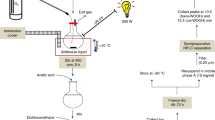Summary
Ketanserin tartrate (ketanserin) is a new antihypertensive drug that is a selective 5HT2 serotonergic receptor antagonist and at high concentrations antagonizes the alpha1-adrenergic receptor. Several reports have indicated that ketanserin clinically decreases plasma low density lipoprotein (LDL) cholesterol. In order to clarify the mechanisms of this LDL cholesterol reduction by ketanserin, we investigated the effects of ketanserin on 3-hydroxy, 3-methylglutaryl coenzyme A(HMG CoA) reductase activity to cultured human skin fibroblasts. We also studied the effects of ritanserin (a 5HT2 serotonergic receptor antagonist) and prazosin HCl (an alpha1-adrenergic receptor antagonist) on HMG CoA reductase activity in cultured human skin fibroblasts. Human skin fibroblasts were cultured in Dulbecco's modified Eagle's (DME) medium containing 10% fetal calf serum. Before the cells reached confluence, the medium was changed to DME containing 10% lipoprotein-deficient serum. After incubation for 48–72 hours, the drugs under investigation were added to the medium. The cells were incubated for 14 hours and harvested after washing with phosphate buffered saline. In our study, ketanserin decreased HMG CoA reductase activity in a dose-dependent manner up to 300 ng/ml (550 nM). Prazosin also decreased HMG CoA reductase activity in a dose-dependent manner up to 40 ng/ml (95 nM); ritanserin decreased HMG CoA reductase activity at concentrations of 100 nM and 200 nM. These findings suggest that the combination of alpha1-adrenergic receptor and 5HT2 serotenergic receptor antagonist effects of ketanserin inhibits HMG CoA reductase activity and that this suppression is probably one of the mechanisms for the plasma LDL cholesterol reduction resulting from ketanserin treatment.
Similar content being viewed by others

References
Veterans Administration Cooperative Study Group on Antihypertensive Agents. Effects of treatment on morbidity in hypertension II: Results in patients with diastolic blood pressure averaging 90 through 114 mmHg. JAMA 1970;213:1143–1152.
Veterans Administration Cooperative Study Group on Antihypertensive Agents. Effects of treatment on morbidity in hypertension III: Influence of age, diastolic pressure and prior cardiovascular disease: Further analysis of side effects. Circulation 1972;45:991–1004.
Multiple Risk Factor Intervention Trial Research Group. Multiple Risk Factor Intervention Trial: Risk factor changes and mortality results. JAMA 1982;248:1465–1477.
Nakamura H. Effects of antihypertensive drugs on plasma lipids. Am J Cardiol 1987;60:24E-28E.
Nakamura H, Hirata F, Yasugi T, et al. Effects of ketanserin tartrate on serum lipids in patients with essential hypertension. Drugs 1988;36(Suppl 1):25–34.
Goldstein JL, Basu SK, Brown MS. Receptor-mediated endocytosis of low-density lipoprotein in cultured cells. Methods Enzymol 1983;98-241–260.
Lowry OH, Rosebrough NJ, Farr AL, et al. Protein measurements with Folin phenol reagent. J Biol Chem 1951; 193:265–275.
Brown MS, Goldstein JL. A receptor mediated pathway for cholesterol homeostasis. Science 1986;232:34–47.
Leren TP. Doxazosin increases low-density lipoprotein receptor activity. Acta Pharmacol Toxicol 1985;56:269–272.
D'Eletto RD, Javitt NB. Effect of doxazosin on cholesterol synthesis in cell culture. J Cardiovasc Pharmacol 1989;13(Suppl 2):S1-S4.
Author information
Authors and Affiliations
Rights and permissions
About this article
Cite this article
Suzukawa, M., Nakamura, H. Effects of ketanserin tartrate on 3-hydroxy, 3-methylglutaryl coenzyme a reductase activity in cultured human skin fibroblasts. Cardiovasc Drug Ther 4, 69–72 (1990). https://doi.org/10.1007/BF00053430
Issue Date:
DOI: https://doi.org/10.1007/BF00053430



